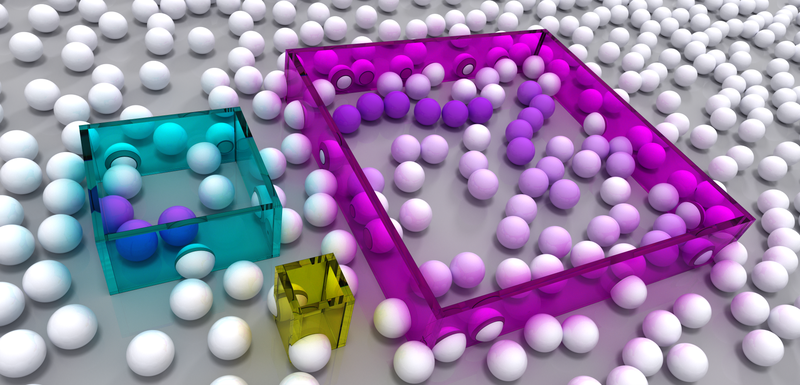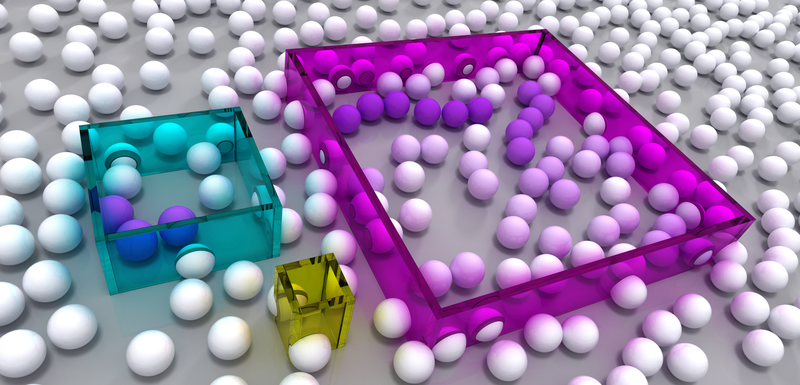Measuring Particle Diffusion with the Countoscope
One way to characterize the interactions in a bacterial colony or a polymer mixture is to trace the path of individual particles through the system, but such tracking can become difficult when the particles are indistinguishable. Researchers have developed a new method that extracts particle dynamics from a simple counting of particles in imaginary boxes of adjustable size [1]. They demonstrated this “countoscope” strategy in experiments with small plastic spheres moving around in a liquid. The measured rate of diffusion was different for different sized boxes, which revealed particle clumping. The countoscope’s ability to identify such collective behavior could one day help researchers understand the mechanisms that cause bacteria and other life forms to group together.
Biologists, chemists, and soft-matter physicists often study many-particle systems in which the particles shuffle around each other in a “random walk.” A useful measure of this behavior is the diffusion constant, which describes how fast an individual particle moves. A measurement of the diffusion constant can tell a biologist whether cells are healthy or sick, or it can tell a chemist how fast a molecule will move through a gel in a chemical-analysis device. The diffusion constant is typically determined by following the path of a single particle in a video recording. This trajectory reconstruction becomes difficult, however, when the particles are numerous and all look the same, says Sophie Marbach from Sorbonne University in France.
Marbach and her colleagues have developed an alternative method that they call the countoscope, which involves counting the number of particles in an imaginary box drawn inside a microscope image. “You can forget about figuring out who went where,” Marbach says. “You just need to know who is where in an image,” she explains. By counting the number of particles as the number fluctuates over time, the team can extract the diffusion constant and other information about the particle dynamics.
Over a century ago, Polish physicist Marian Smoluchowski observed particles under a microscope and noted the number of particles changing over time. But while Smoluchowski counted only about a half-dozen particles, the countoscope counts thousands of particles in each frame, thanks to image-recognition software. Another difference is that Marbach and colleagues can select the size of their counting box to study the dynamics at small and large scales.
To demonstrate the method, the researchers placed a 2D layer of 2.8-µm-wide plastic spheres in a water-filled cell. To analyze this “colloidal” system, the researchers selected boxes with various side lengths, from 4 to 32 µm, and their software counted, frame by frame, the number of particles in each box. They computed the quantity ⟨ΔN2 ⟩, the mean-squared change in particle number with respect to the first frame, which is mathematically similar to the mean-squared displacement that describes the random walk of a single particle. The researchers found that ⟨ΔN2 ⟩ increases with time, and from the rate of this increase, they determined the diffusion constant of the colloid. Their diffusion value matched that coming from the more traditional trajectory-reconstruction method.
The researchers then repeated the experiments with higher densities—that is, with a higher average number of particles in a given area. As the density increased, particles diffused more slowly, which is expected from the extra crowding. But the researchers also saw what are called collective effects, such as particles temporarily forming bunches, or aggregates, of about 10 particles. Previous studies have not been able to examine this behavior closely. “If you track a single particle, it’s very hard to tell how the pack moves because you’re only following one,” Marbach says.
But the countoscope—with its small and large boxes—can zoom in on this collective behavior to try to uncover the mechanisms that control it. In their experiments, Marbach and her colleagues found that the temporary bunches move more quickly than expected, suggesting that some hydrodynamic effects are missing from the standard colloidal models. “We’re not entirely sure of the details, but it’s something new that we've been able to measure,” she says.
“I see the countoscope as a promising alternative to particle tracking, as it eliminates the need to reconstruct particle trajectories,” says soft-matter physicist Roberto Cerbino from the University of Vienna. He points out that there exist other techniques that also measure particle numbers, but only indirectly, for example, by observing the total light coming from fluorescent particles or from scattering particles. Compared to these indirect methods, the countoscope “is more flexible and modern, supported by detailed calculations across various scenarios,” Cerbino says.
–Michael Schirber
Michael Schirber is a Corresponding Editor for Physics Magazine based in Lyon, France.
References
- E. K. R. Mackay et al., “The countoscope: Measuring self and collective dynamics without trajectories,” Phys. Rev. X 14, 041016 (2024).





